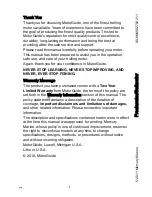
http://www.tyan.com
114
Note: You should always clear your CMOS after flashing a BIOS. This will
clear out any stray settings from your old BIOS which may have been carried
over from the flashing process. Most problems encountered after flashing a
BIOS
will be solved by this simple procedure (see Hardware CMOS & Password
Reset, page 41).
To reprogram the system BIOS, the CPU must be running in real mode. FMW
will not run if the CPU is operating in a protected or virtual mode. This means
that you cannot run it with Windows running or with any memory manager
software. You must disable any memory manager software before you can run
FMW. The easiest way to do this is as follows:
1) Boot your system from a bootable floppy disk with no CONFIG.SYS or
AUTOEXEC.BAT files, and then run FMW from a backup copy of your
support disk. You can make your back-up floppy bootable when you format it,
and use one disk for both purposes.
2) If you are using MS-DOS 6.x, you can use the feature that allows you to
bypass the CONFIG.SYS and AUTOEXEC.BAT files. You can access this
feature by pressing <F5> while the Starting MS-DOS... line is on the screen
during boot-up.
If you are uncertain whether or not you have a memory manager running, try
FMW. If it works, then there is no active memory manager on your system. If
you see a warning message about the CPU mode, follow the above directions
to get around the memory manager.
Once you have your CPU in real mode, you can run FMW. You can copy the
contents of the Flash directory to your hard drive, or you can run the utility
from a backup of the support floppy disk. Either way, make sure that the new
BIOS file is in the same directory as the FMW utility.
To start FMW, change to the Flash directory if you are not already in it.
Type awdflash at the DOS command line and press the <Enter> key. The
FMW utility screen will appear:
BIOS 2
Award BIOS Configuration




































